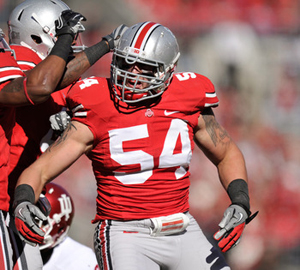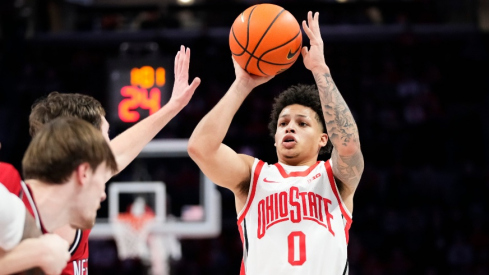 Seal of the state of college football.
Seal of the state of college football.If the phrase was a paperback it would have dog-eared pages, a broken binding and a torn cover. It’s as worn out as the day is long, but there’s a reason for its widespread use: it’s true.
Arguably, the saying has never carried more veracity than when referenced in terms of college football. ANY team has a chance on Saturday if they can field eleven guys who can put the clamps on the opposition’s talent.
But, it’s the teams that can do it consistently, (against anyone) that win the crystal trophy. With that said, who better to analyze than past championship winning defenses to discern how far Ohio State’s Silver Bullets are from winning one themselves?
Methodology
I took a look at the defensive statistics of the past five college football national champions. Specifically I looked at total rush yards given up, total pass yards given up, total yards against, total defensive plays over the course of the season, average yards given up per play, total sacks, total interceptions and total forced fumbles.
Those totals were then averaged to set “championship defense benchmarks.”
Finally, the averaged figures were compared with the same statistics from OSU’s 2011 defense to determine how close OSU’s current D is from championship caliber.
It’s important to note this comparison isn’t exactly a one-to-one. All of the past five national champions played in the SEC (*slaps forehead lets out long sigh*) Ohio State didn’t. The competition the defenses went up against week after week wasn’t exactly the same.
In addition, Ohio State’s 2011 team was a squad in-flux. Possibly as a result, the defense wasn’t as stout as those seen in the past. However, the only relevant comparison would come from juxtaposing the past national champs with the most recent Buckeye D.
 John Simon likes numbers...so should you!
John Simon likes numbers...so should you!Trends
Before jumping in, I wanted to highlight a few interesting commonalities discovered when analyzing the championship defenses of the past five years (beyond their conference affiliations).
Each defense had at least 30 sacks over the course of the season and at least 12 interceptions. In addition, each defense never gave up more than 5.5 yards per play.
Finally, with the exception of Auburn’s defense in 2010 (that may have been victim to Cam Newton’s quick strike abilities) no D was on the field for more than 915 plays during the course of the season.
Championship Defense Benchmarks Compared to 2011 Ohio State Statistics
To reiterate, key statistics from the past five national champion defenses were averaged to set “championship defense benchmarks.” Those figures were then compared to the performance of the 2011 Ohio State defense.
| Rush Yds | Pass Yds | Total Yds | Total Plays | Yds/Play | Yds/Game | Sacks | Ints | FF | |
|---|---|---|---|---|---|---|---|---|---|
| Benchmarks | 1,307.4 | 2,495.8 | 3,803.2 | 867.2 | 4.34 | 274.3 | 33.2 | 19.6 | 11.2 |
| '11 OSU | 1,840.0 | 2,366.0 | 4,206.0 | 831.0 | 5.06 | 323.5 | 23.0 | 13.0 | 10.0 |
Key Findings
RUSH DEFENSE MUST IMPROVE: The 2011 Silver Bullets gave up nearly 533 more rushing yards during the season than the championship squads on average. But look for this stat to vastly improve in 2012.
Last year, the defensive line and linebacking corps were relatively green and bereft of the defensive leader the respective units have seen in the past. With a more seasoned clientele, leaders emerging in the form of Simon and Hankins, and a coaching staff dead-set on getting pressure, the chasm between rushing yards given up by championship squads and Ohio State’s D in 2012 should shrink substantially.
TOTAL PLAYS WERE LOWER THAN AVERAGE: Ohio State’s 2011 D saw the field 36 times less than the past five championship defenses on average. This might have more to do with Tressel Ball’s dying breath in 2011, but at the end of the day, there was a reason Coach T put such an emphasis on a slow methodic offensive machine. Simply put: it keeps a defense fresh.
Quick strike offenses like Cam Newton’s in 2010 put points on the board in bunches but they also keep your defense on the field. Auburn’s 2010 D tallied almost 50 more plays during the season than the next highest championship defense. In addition, Auburns defense in 2010 racked up 243 more plays than Alabama’s 2011 squad.
While Urban Meyer and Tom Herman have Columbus abuzz over the new look no-huddle offense, it’s important to keep in mind quick strike philosophies put a substantial amount of mileage on a defensive unit.
GIVING UP TOO MANY YARDS PER PLAY: Ohio State’s defense gave up over 5 yards per play last season. Unless you have an offense equipped to keep you in a shoot-out (see Auburn 2010), you aren’t going to win many games with that number.
The championship defense benchmark was 4.34 yards per play. Without Auburn’s 5.4 yards per play outlier, the number was closer to an even 4.
Ohio State’s high per play average was driven mainly by their inability to stop the run effectively last season. If that problem is corrected, there is no reason to believe this number wont level out.
NEED MORE PRESSURE AND TAKEAWAYS: While OSU was right on par with the forced fumble average of the past five national champions, (OSU = 10, Champions = 11.2) the Buckeye’s sack and interception totals were much less.
Last season, the Silver Bullets fell 10 sacks and 7 interceptions below the championship defense benchmark.
The two stats are directly related. Get pressure on the QB and he’ll make a mistake. Sometimes those mistakes will end up in an opposing player’s arms. Again, getting this production where it needs to be will have everything to do with the ability of the defensive line and linebackers disrupting things in the opposition’s backfield on a more consistent basis.
Getting the kind of pressure that these championship squads generated might be the most important factor in terms of winning a championship (Ohio State saw it first hand in 2006). Forcing the QB to make a decision before he wants to will always result in a net positive result for the defense, ultimately parlaying into more opportunities for the offense.
Defense wins championships. It was true during the days of Woody Hayes just as it was a key factor in Alabama hoisting the trophy last season. Outliers like Auburn do exist: an outstanding offense bolstered by a serviceable defense, but they’re rare.
My hope is that creating and analyzing championship defense benchmarks like those outlined in this article will help in the understanding of what it will take for Ohio State’s defense to improve and excel. In theory, if the benchmarks are approached or even met in 2012, it should propel OSU back into college football's upper echelon.

